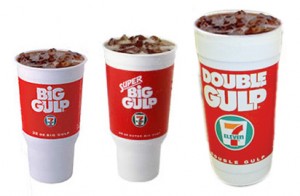When was the last time you ordered a “small” beverage at a coffee bar — and you received a small drink without being asked if by small you actually meant tall or medium? Doesn’t “medium” mean somewhere in between small and large? The OED defines it as “a middle quality, degree, or condition; something intermediate in nature or degree” (noun), or as “intermediate between two or more degrees in size, character, amount, quality, etc.” (adj). So how can you order a medium anything if there isn’t a smaller version regressing it towards the mean?
And don’t think that ordering a “large” is any easier. We’re in the US, dude, where it’s 50 shades of huge, and medium is the new small. “Venti”, “grande”, “trenta”, we all demand exotically: as long as the order has an Italian vowel at the end to make it sound suitably grandioso, we’re OK. But we know we’ll be on the hunt for a WC (and possibly a crash-cart) long before we’re likely to see any dregs in the bottom of the coffee cup …
In May 2012, New York Mayor Michael Bloomberg announced his intention to restrict the sale of sugary soft drinks in his bid to fight an epidemic of obesity and obesity-related diseases. His plan was to limit the size of sweet beverages sold in movie theaters, restaurants, stadiums and arenas to 16 ounces (0.5 litres). Let’s just emphasize that: To limit the size to 16 oz. It is common in the US to find 32-ounce and even 44-ounce cups of sugary drinks. Back in the 50s, McDonald’s sold only one size of soda: 7 oz. Today, a “small” ordered in that storied joint will get you 12 ounces; a “large” siphons 32 oz of sweet nothings into your arteries and kidneys. It was only after the huge success and impact of the hilarious and hard-hitting movie Supersize Me in 2004 that McDonald’s did away with its longtime marketing campaign to encourage its customers to upgrade or “supersize” their orders (and themselves).
Perhaps the greatest and cruelest irony is the name of the largest portion on offer in today’s U.S. and UK eateries. Yes, restaurant chains such as Britain’s Beefeater and America’s Chili’s let you order “bottomless” chips — and that doesn’t translate to ‘you will lose your bottom once you’ve consumed that infinite portion of fried fare’. “Bottomless” you will not be; lifeless you might… (In France, they word this portion size more delicately: “à volonté” — meaning literally “at will”, which puts your fat and your fate more firmly into your own hands.)
Needless to say, Mr. Bloomberg was thwarted in his attempt to make us more bottomless and less supersized. Apparently he’s now moving on to elevators …
~~~~~~
Further reading: About.com tells us all we’ll ever need to know about Starbucks drink sizes:
Demi — Literally, ‘demi’ means ‘half.’ Unlike most Starbucks drink size names, it is of French origin (not Italian origin). The Demi size is the smallest size at Starbucks, and is used to describe an espresso drink size. It’s three ounces (89 milliliters), which sounds tiny until you realize it’s only for standard espressoshots, which are usually only about one ounce each. And that a double shot is usually under two ounces. Yikes!
Short — The ‘Short’ was one of the two original Starbucks cup sizes. (The other was ‘Tall.’ Makes sense.) It’s a mere eight fluid ounces (240 mL), and aside from the Demi (which is mostly a size espresso shots), it’s the smallest drink size available at Starbucks. For many people who drink coffee at home, six to eight ounces is a standard cup size.
Tall — The ‘Tall’ is the other original Starbucks drink size. When Starbucks started, the Tall was basically a Large. Now, it’s basically a Small. In fact, if you order a ‘Small’ at Starbucks, you get a Tall. A Starbucks Tall measures in at 12 US fluid ounces (350 milliliters).
Grande — Pronounced GRAWN-day, ‘Grande’ is Italian, Spanish, Portuguese and French for ‘Large,’ but at Starbucks there are two even larger drinks, the Venti and the Trenti. The Grande is 16 US fluid ounces (470 milliliters / 2.5 cups).
Venti — Pronounced VENN-tee, Venti is Italian for 20. A Venti is 20 ounces (590 milliliters), so in a way, this name makes sense… until you realize that none of the smaller portions have names that relate to their sizes numerically.
Trenta — Introduced in 2011, the ‘Trenta’ is the newest (and the largest) of Starbucks drink sizes. ‘Trenta’ means 30. You might be thinking, “Oh, it’s a continuation of the Trenta theme. It’s 30 ounces.” Nope. Strangely, it’s 31 ounces (920 milliliters). It’s almost as though 30 ounces wasn’t enough to make it the ‘Big Gulp’ of the coffee world. The Trenta size is reserved for iced drinks only (including iced coffee, iced tea, lemonade and other drinks served over ice), and it usually costs about 50 cents more than a Venti of the same drink.
These sizes apply for most hot Starbucks coffee drinks and espresso drinks. However, there are a few exceptions, the most noteworthy of which is the sizing of iced Venti drinks. Iced Venti Drinks are usually 24 ounces rather than 20 ounces. According to the Starbucks website, the Iced Cocoa Cappuccino* is an exception to this — the iced version is still 20 ounces. Venti (20 oz, not the usual 24-oz Venti iced drink cup size).
* see previous Glossophilia post about knowing your coffees
Thanks to Max, the Venti of @TeamAwesomeNYC, for the grande idea

